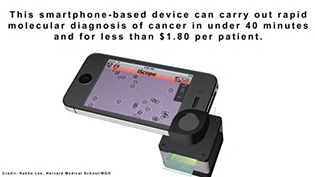The SIG Beat
NEWS FROM AND ABOUT THE NIH SCIENTIFIC INTEREST GROUPS
New Technologies to Improve Global Health
NIH Global Health Interest Group Hosts Symposium
Portable technologies, Earth-observing satellites, developmental economics, social media, and infrastructure improvements are all playing a role in improving global health. The NIH Global Health Interest Group invited experts to explore these topics at a symposium held on the NIH campus, on October 24, 2016.
Innovations: Krishna Kandarpa (National Institute of Biomedical Imaging and Bioengineering, NIBIB) highlighted NIBIB innovations that are ideal for resource-limited settings: the iScope and a low-cost magnetic resonance imaging (MRI) machine. The iScope is a microscope that can be mounted on a mobile phone to detect abnormalities in a patient’s blood and can even diagnose cancer in less than 40 minutes and for less than $1.80 per patient. The low-cost, compact, 3.0-tesla MRI machine uses flexible MRI radiofrequency coils that produce high-quality images and in the future could lead to shorter scan times. Its weight is one-fourth that of a traditional MRI machine, and it takes up half the space.

NIBIB innovations are ideal for resource-poor areas. Shown: The iScope, which can be mounted on a mobile phone to detect abnormalities in a patient’s blood and can even diagnose cancer in less than 40 minutes and for less than $1.80 per patient.
Satellites: NASA program manager John Haynes described how satellite technology is being used to understand the planet’s changing climate and to predict or confirm outbreaks. The International A-Train, a convoy of six satellites (from the United States and other countries), takes measurements of temperature, water vapor, and rainfall. It has instruments that offer three-dimensional views of clouds and airborne particles, and it produces high-resolution vertical maps of greenhouse gases and other atmospheric constituents. Scientists have been able to use this technology to monitor the developments of El Nino and other weather events. Haynes described other programs including SERVIR, a satellite-based joint venture between NASA and the U.S. Agency for International Development, which provides predictive models for environmental management, disaster response, and climate-change adaptation; and ASMR-E (advanced microwave scanning radiometer), which analyzes air-temperature and freeze-thaw data, surface-soil moisture, and fractional open water cover to improve forecasting of mosquito-borne disease outbreaks, such as West Nile virus and Zika.
Economic motivators: Developmental economist Sarah Baird (George Washington University, Washington, D.C.) does research on the microeconomics of health and education in developing countries. She described a cash-transfer program targeted at adolescent girls in Malawi. Her study assessed two types of transfer programs—money given unconditionally (UCT) or money given with conditions (CCT), usually based on school attendance or health care. The CCT program had a significant effect on schooling (enrollment, attendance, and test scores) and delayed marriage, but it resulted in no improvements in employment, wages, or sense of empowerment. The UCT program initially had a large effect on decreasing pregnancy, young marriages, and human immunodeficiency virus infection, but these effects vanished two years after the girls finished the program. Baird’s study concluded that although cash transfers can generate a wide variety of benefits for adolescent girls at the time they are receiving them, many of these benefits do not last.
Social media: Global-media specialist Silvio Waisbor (George Washington University) spoke of how social media could improve health by increasing interactions between patients and their health-care providers. For example, being able to communicate via FaceTime with a psychiatrist could be beneficial in African countries that have only one psychiatrist for the entire country. In addition, social media has increased accessibility and widened access to health information. Ultimately, said Waisbor, social media works best when integrated with traditional communication approaches.

In war-torn areas, like Syria, hospitals are being destroyed. Shown, the ruins of the Kindi hospital in Aleppo.
Infrastructure: Keith Martin, a physician and the executive director of the Consortium of Universities for Global Health (Washington, D.C.), warned that although developing new technologies and innovations is important, it’s also essential to strengthen the basic infrastructure in developing countries. For example, 40 percent of the hospitals in Liberia do not have such fundamentals as sanitation, soap, and electricity. He displayed a photograph of an outpatient procedure room, which was essentially a cot with a sheet, a bucket, and some rudimentary instruments. And in war-torn areas, like Aleppo, Syria, hospitals have been destroyed. He said that although most of these countries receive foreign aid, it’s estimated that poor countries lose $1 trillion a year to corruption. Martin suggested that one way that NIH researchers (or retirees) could help is by training health-care workers in developing countries.
For more information on the NIH-Global Health Interest Group, visit https://sigs.nih.gov/globalhealth/Pages/default.aspx or contact Gyan “John” Prakash at prakashg@mail.nih.gov. To sign up for the NIH-GHIG LISTSERV, go to https://list.nih.gov/cgi-bin/wa.exe?A0=GLOBAL_HEALTH_INTEREST_GROUP.
NEW SIG: NEUROSCIENCE CLINICAL TRIALS
The Neuroscience Clinical Trials interest group will facilitate the NIH-wide exchange of ideas and experiences related to the planning and conducting of clinical trials in clinical neurosciences. This exchange includes the sharing of best practices across individual institutions, jointly discussing areas that would benefit from coordinated efforts (for example, the establishment of standards across NIH), and offering a forum for presentation and discussion of research projects and initiatives involving innovative approaches to the methodology of clinical trials. The group formed as one outcome of an annual retreat that included institutes doing intramural research in the clinical neurosciences (NINDS, NIMH, NIDA, NIAAA, NIA, NINR, NCCIH, and others). By becoming a SIG, the group is opening itself to interested participants and contributors from within and beyond the NIH intramural research program. Activities will include regular meetings as well as a LISTSERV to announce meetings and clinical-trials-related activities across NIH (such as seminars and fellowship opportunities). For more information or to be added to the LISTSERV, contact Dietrich Haubenberger at haubenbergerd@ninds.nih.gov.
This page was last updated on Monday, April 11, 2022
